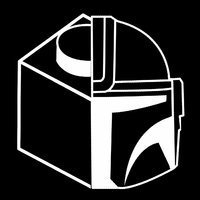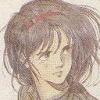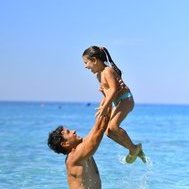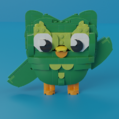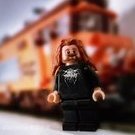Search the Community
Showing results for tags 'MOC'.
Found 5702 results
-
"The Golden Frog" Restaurant (Restaurant "Zum Goldenen Frosch") Alost two years after my last MOC it's finally time to reveal my latest work. This is a modular building with a restaurant - "The Golden Frog" (or "Zum Goldenen Frosch" in german) on the ground floor. The second floor houses a psychotherapists office, and the top two floors feature an apartment. Summary: Parts: 5650 (excluding minifigs) Design: designed in stud.io from May to June 2021 and from December 2021 until March 2022 (got hard stuck with the design last summer and worked on other projects for a while). Highlights include the roof, where I tried to mimic the typical look of a copper plate roof as found on many older european buildings, the facade featuring lots of snot work, and the glass spiral staircase leading from third to the fourth floor. As usual, the model also has full interior. The color scheme using bright light orange might not be everyone's cup of tea, but I really like the color, so there you are As usual, head over to flickr for even more pictures: https://flic.kr/s/aHBqjzRQmw The copper plate roof. I'll leave it to you to figure out how it is built - I'll just say that all pieces are firmly connected. The restaurant's namesake is featured above the windows and door on the ground floor. Interior of the restaurant. The restaurant also features a piece by a local modern artist. It's cryptically titled "Entrails of a Star Destroyer". On the second floor, a psychotherapist has his office. Many of his patients find the loud ticking of the grandfather clock to be distracting. He enjoys analyzing their reactions to it. The third floor is the first of a two floor apartment. This floor has a kitchen, eating area and home-office working space. The luxurious kitchen has a big fridge and a kitchen island with further seating. The glass spiral staircase leads up to the final floor. It is built using panels. Curved slopes with cut-out create the nice organic shape of the banister. The top floor is less spacious then the ones below. It features the bedroom, couch and TV area and the bathroom. The bathroom features a big, open shower (with a coloured glass wall preventing spray down the staircase), toilet and wash basin. I hope you enjoyed my MOC - looking forward to any feedback, constructive criticism or praise you have to offer More pics on flickr: https://flic.kr/s/aHBqjzRQmw Tobias
- 25 replies
-
- modular building
- restaurant
-
(and 1 more)
Tagged with:
-
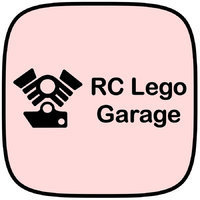
[MOC] EAGLE an RC Trophy Truck
Daniel-99 posted a topic in LEGO Technic, Mindstorms, Model Team and Scale Modeling
Hey, guys! After a 3-month brake from Lego, I am glad to show you my new RC trophy truck, called Eagle. I apologise for the quality of photos and I will try to improve them later after I will get myself a studio light. I will also make a proper introductory video when I will get enough outdoor footage. Features Responsive long-travel suspension with 4-link live-axle at the rear and double wishbone at the front Brushless motor A2212 1200 kv for propulsion, Geek Servo for steering, 1500 mAh 3S Li-Po for power Strong and efficient transmission with metal U-joints and metal bearings. Great ground clearance for outdoor use, 95 mm RC wheels Light-weight bodywork Experience and Inspiration I guess that nobody will be surprised If I would make a confession that I have a deep passion for Trophy trucks. This type of vehicle suits the best for the role of a fast RC Lego cars which are build for outdoors. Indeed, outdoor environment is always rough and "bumpy" for Lego cars. I took my inspiration and first experience form several well-known Lego builders, such as: Sariel RM8 ZeroBricks GooberReboot Through the last 3 years of intensive engineering I made a few attempts in building myself a "proper" trophy truck. Each of them had it`s own features and technical problems: Heavy-duty Trophy Truck: RWD, 2x BM, 2x Buwizz 3.0 units, 95mm wheels. Problems: "big scale" which caused a serious load for motors, over-tilted front caster. Phantom: RWD, 2x BM, Leshy control unit, 85mm wheels, mid scale. Problems: lack of power from Leshy unit, lack of articulation at the rear, plastic wearing in the wheel hubs. Wilde Beast: 4WD, 4x BM, Wixy RC control + 3S Lipo, 95mm wheels. Problems: "big scale" which caused a serious load for motors, indep. susp. with a questionable geometry. Falcon: 4WD, 4x BM, Wixy RC control + 3S Lipo, 75mm wheels. Problems: indep. susp. with a questionable geometry, overheating of motors at the maximal RPM. About a year ago I switched from Lego Buggy motors to a Brushless motor (for the reasons which will be covered later). This was not an easy switch for me and I had to learn some RC electronics theory and find the proper ways of using brushless motors with Lego. My latest RC cars with Brushless motors was: Unimog trial truck Pathfinder SUV Hornet 4x4 buggy With pathfinder and Unimog projects I studied the 4-link live-axle suspension geometry, while with Hornet project I found the way to achieve a proper suspension and steering geometry with my custom wheel hubs. With this projects completed I get myself all cars I need. - What should I build next? With such question in mind, I faced a deep burnout from Lego, so I decided to take a summer brake. Hot summer days returned me my passion for Lego, and I had a plenty of time to plan a new project. I felt myself ready to make another attempt in building myself a "proper" trophy truck. That is how the story begins. Electronics With my latest truck Falcon I reached the limit of what Buwizz motors could handle. Some time ago there was a discussion about efficiency and power-to-weight ratio. I would not resist that with the growing number of motors and Buwizz units, one could get a better power-to-weight ratio, though such a way faces the problem of plastic-weariness quite soon. With the growth of the number of motors, also grows the size of the car and it`s total weight, which get distributed to the four Lego plastic wheel hubs! I faced the plastic-weariness problem of Lego hubs with my Phantom truck, and solved it by purchasing custom wheel hubs with metal bearings, which I were used in the Falcon truck. Moreover, there was no gearing in the transmission of the Falcon truck: each wheel was connected to it`s own motor via driveshaft with metal bearings. With 4x Buwizz motors on board, powered by strong 3S Li-Po battery, Falcon had a great power-to-weight ratio. Through multiple tests I found that It can not handle full throttle for more than 45 seconds due to the rear motor overheating. It was pretty clear to me that RC Li-Po could easily overfeed 8 or even 12 motors with power, so there was no sense in adding more BM motors. Likely to me, one Russian AFOL developed a 3D-printed housing for Brushless A2212 motor which allowed to use it with Lego. I purchased two sets from him, and mot I have 100% RC setup. There was no problem with the lack of power or motor overheating anymore, but it was a real challenge for me to overcome this energy! Transmission With BM motors it is very natural to distribute the torque among axles \ wheels, by having separate transmissions to each axle \ wheel. But with Brushless motor I had to use "realistic" transmission, since there is only one output with a plenty of speed and torque. Despite the fact this motor is a baby-motor in the world of RC cars, It has enough power to twist Lego axles with instant reaction to the throttle. Custom 3D-printed housing has a 4:1 planetary reduction, but the speed of the output is enough to cause gear-melting. That is why the following decisions were made: use metal U-joints all around, most of them have a 3L lego axle glued from one side to prevent them from falling off. use silicone grease to lubricate the planetary gear in the motor housing and some external gearings. use custom parts with metal bearings to separate the transmission from the car frame. use carbon-fiber axles in the central driveshafts. The new Eagle truck has a very simple RWD transmission with a single "external" 14:23 gearing in the differential. Recall, that the 3D-printed motor housing has a 4:1 gear reduction. So the motor is connected to the differential via carbon-fiber driveshaft. From the differential power translates to the 95 mm RC wheels via half-axles with metal U-joints. The whole transmission sit on the metal bearings (custom wheel hubs with metal bearings, custom 5x7 frame with metal bearings for differential housing, motor output passes through the connector with the metal bearing). Surely you have noticed that I lifted the central differential by one stud over the wheel axle in order to achieve a higher ground clearance! Which differential to use RED or YELLOW? RED differential has a 28:12 reduction which reduces the load from the driveshaft and the motor. Moreover, such gear ratio is more realistic. On the other hand, YELLOW differential has bigger teeth so it is stronger. But more importantly, is that YELLOW differential is 125% more efficient than the RED one, since it has bigger gears and does not scratch the 5x7 frame under the load. In fact, I am using a custom torsen differential with 23-tooth gear. It also does not scratch the 5x7 frame and hold half-axles much stronger than the original YELLOW diff. Suspension Trophy truck is all about suspension, and it was the most challenging part for me! Non of my previous trophy trucks has a proper suspension: it was either rear live-axle without articulation (Phantom, heavy-duty trophy truck) or independed rear suspension (Wilde Beast, Falcon). As I found from multiple driving tests of Phantom, rear axle need an articulation, cause otherwise RWD car loose the speed on bumps. IRS give the desired articulation and stability, moreover it is very simple to build and it has a low unsprung mass. Despite that IRS has a limited articulation and it is not presented in real Trophy Trucks either! Lego engineers designed a ball-joint connection, which is used in many Trophy trucks. It gives a single-lever suspension (with it`s simplicity and stiffness) and desirable articulation. Well, I did not use it, since it has no metal bearings for the U-joint inside the ball. So I had to replicate the 4-link live axle. 12-long reinforced suspension arms, invested upper triangle, 9.5 L springs, attached to the mid of lower suspension arms, Anti row-bar with a carbon-fiber axle, Now let`s move the the front suspension. Surely, real Trophy Truck has a complex front suspension, which is impossible to replicate with lego bricks. Though lego-ish version share important principles with real prototypes: double wishbone with 8L suspension arms (9L was too wide here) Positive caster angle Reinforced lower arms Shock is attached to the lower arm closer to the center of the car Steering rack is located in the front of the car Again I use custom wheel hubs with metal bearings. They have an inverted lower arm mounting point, though it is possible to use Lego hubs instead. With hart 9.5 L springs the front suspension has a long travel, moreover it has a great balance btw softness and responsiveness + side-way support. Bodywork & Frame In order to achieve a positive caster angle I tilted the lower part of the frame. At the same time, the upper part of the frame. At the very front of the car upper and lower parts of the frame meets together which form the "almost right-angle" triangle with lengths: 13+1, 14+1 and 5+1. (right-angle triangle has the following lengths: 12+1, 13+1 and 5+1). Second time I use the Pythagoras theorem to make a force triangle for the rear springs attachment points. I tried to keep the frame of the truck in 13-15 studs wide, to use 15L liftarms for cross braces. I was Luckily to me I was able to squeeze all electronics into cockpit. This give the model 50:50 weight distribution and a "low" (for such high car) gravity center. Well, one would prefer to obtain 35:65 weight distribution for the RWD truck, but It would raise the gravity center and would require extra structure over the rear axle. The whole bodywork consist of 24 panels and a few bricks, so it does not cause much weight to the truck. -
Hello Corvette, A-Team and Speed Champions fans, the Chevrolet Corvette C4, colloquially known as the 'Vette, is a two-door, two-passenger sports car manufactured and marketed by Chevrolet across more than 60 years of production and eight design generations. The fourth-generation was the first complete redesign of the Corvette since 1963 and it is known for its sleek look. It was produced from 1983 to 1996. This color scheme of this model is based Faceman's 1984 Corvette from "The A-Team" which is an American action-adventure television series that ran on NBC from January 1983 to March 1987 about former members of a fictitious United States Army Special Forces unit. Building instructions are available on the following links: It is a studless build in the new, 8 studs wide Speed Champions style. I wanted to create a sleek model which is as accurate as possible in this small scale. I prefer to minimize the use of stickers to keep the flexibility of the used parts in further builds, and therefore this model include only two vehicle registration plate stickers. My intent was to keep the width-length-height ratio of the real car and this size makes it possible. The model contains lots of details: for example the emblematic color scheme with the red and black stripes on the sides, the glass hatchback, the side-view mirrors, the tiltable seats etc.. Maybe the most challenging one was the iconic rear side with the vehicle registration plate, here there is a half stud offset. I tried to fill every unnecessary gaps and therefore some tricky build techniques are used. The model has space for two minifigures. I suggest to use small hairs. Without the seats minifigures with bigger hairs can be used too if they are leaned back. Thanks for visiting, _TLG_ Corvette C4 - A-Team, Instructions 1 by László Torma, on Flickr Corvette C4 - A-Team, Instructions 2 by László Torma, on Flickr Corvette C4 - A-Team, Instructions 3 by László Torma, on Flickr Corvette C4 - A-Team, Instructions 4 by László Torma, on Flickr Corvette C4 - A-Team, Instructions 5 by László Torma, on Flickr Corvette C4 - A-Team, Instructions 6 by László Torma, on Flickr Corvette C4 - A-Team, Instructions 7 by László Torma, on Flickr
- 8 replies
-
- the a-team
- a-team
- (and 17 more)
-
Pippin is trying to explain that they're lost but Merry's not listening - he's just found a biscuit in his pocket! Just playing around with a few ideas ahead of a much bigger moc I'm planning. This is one is a test of a waterfall/stream technique I wanted to try. I got hold of about 30 this part and figured it might make a decent flowing water effect. But in the end it was a lot more difficult than I anticipated because there's not much back/forward rotation in the clips. I ended up with quite a few 'illegal' connections, although I think they could be designed out with a bit of planning. I quite like the end result - I think I got some of the flowing movement I was after, although I next time I'm going to try adding some tan/dark tan under the water pieces to simulate the stream bed. Hopefully it will help emphasise the effect more. Anyway, hope you enjoy the pics - comments/suggestions welcome! Edit: Thanks for the frontpage!
-
A 20-gun frigate assigned to hunting those pirates! Also carries a treasure chest, for those who dare... Or perhaps the appearance of a ship like this has forced the pirates into hiding? This is an extremely ambitious design with a smoothly curving hull built on a sturdy technic frame and a detailed, Minifigure-friendly, interior. I have built many sailing ships in LEGO before, and this is my best work so far, including all the techniques and features that I always wanted to include. Vote now if you want this design to be officially produced by LEGO as part of the BrickLink Designer Program: https://www.bricklink.com/v3/designer-program/series-3/1167/Imperial-Frigate-Concordia The 16 brick-built cannons on the gun deck can individually slide back and forth and all the gun ports can be closed when the cannons are in the back position. The capstan is also attached to a string reel and can be made working. Further details below deck include the galley, storage compartment and captain's cabin. Most of the top deck can be removed to access the gun deck. Minifigures can stand below deck and all gaps in the hull are filled. I also made a video to show the building experience, including the entirely brick-built & smoothly curving hull: More pictures can be found on the BrickLink submission page: https://www.bricklink.com/v3/designer-program/series-3/1167/Imperial-Frigate-Concordia VOTE NOW
-
Hello everyone. So first of all this model is design by Ninynuts which was based after TT's design used for Lego Batman 3.I say it's his design because he changed some pieces and well he build the hole thing. Nintynut's Arkham Knight Batmobile-Battle mode by FTG Prime (Customs MOC's and random stuff), en Flickr The only thing that i did was build the model IRL that included modding the thing to be a little more steady(the main body is really solid actually),unfortunaly i had to glue some parts of the vehicle it self in order to be sturdy because some of the parts are just connected by 1 stud. Something i found while building this beauty was that the windshield does not exist on Trans-Clear or Trans-Black which kinda sucks(if TLG releases one in those colors i'll update the photos). Also i would love to post this when the game was released but i had some issues to get the windshield. The car as you can see on the photos has a fully functional Pursuit Mode and Battle Mode,unfortunally she doesn´t roll because i added 2 2x4 Trans-Clear bricks to balance the wheight. Nintynut's Arkham Knight Batmobile-Pursuit mode. by FTG Prime (Customs MOC's and random stuff), en Flickr Nintynut's Arkham Knight Batmobile-Pursuit mode(Front) by FTG Prime (Customs MOC's and random stuff), en Flickr Nintynut's Arkham Knight Batmobile-Battle mode(360-wheel spin) by FTG Prime (Customs MOC's and random stuff), en Flickr Nintynut's Arkham Knight Batmobile-Battle mode(Back) by FTG Prime (Customs MOC's and random stuff), en Flickr Also i´m sorry if this post is kinda messy but this is my first time posting actuallly something here on Eurobricks. Here's the LEGO Ideas page if you want to show your support:"https://ideas.lego.c...projects/89313" I hope that you love this thing as much as i do,any type of feedback is welcome. Be the Batman.
- 11 replies
-
Hi all! I made this Galaxy Explorer Ground Base from the leftover parts in set 10497 after building the smallest One Man Space Ship alt build. This is the original: Here's mine: In addition to the command base & comm tower, there's a power station, small landing pad, some craters, a small speeder, and a rover. Command base: Comm tower: Power station: Landing pad and speeder: Rover (which I think is hilarious because the truck/storage bed is under the driver's seat): Anyway, I had a ton of fun building this. Thanks for looking!
- 18 replies
-
- classic space
- 10497
-
(and 4 more)
Tagged with:
-
I thought it would be fun to have a thread just for sharing really awesome MOCs that other people created. I know looking at awesome stuff helps to get me inspired. My first ever Lego Space set was Starfleet Voyager. One really awesome Lego builder, Chris Giddens, created TWO remakes of this set that are both amazing! The first one is here: His more recent one is here: Two of my other favorite MOCs are by Peter Moris as part of his Classic Space Evolved set. This first one is remake of the Twin Starfire, a ridiculous set from the 80s that he made awesome: The other one I really like of his is his radical remake of FX Star Patroller, which is a mashup with the Mospeada Legioss & Tread (also known as the Robotech Alpha and Beta fighters):
-
Ahoy there! This is an entry for the Mini Set Category. In the middle of the Caribbean, there is a tiny island with a palm tree where the fearless pirate Cutlass Jane hides here treasure. A skull marks the spot! Use the shovel to remove the sand and reveal the shiny doubloons! This 30-piece set also includes a small tub and paddle that she can use to get to the island. This would be the first mini set to feature a female pirate! I hope ye fancy me entry. Comment away, mateys!
- 18 replies
-
THE MASK OF ZORRO left its mark to my childhood in 1998. At my young age, I was pretty impressed what I watched. The way that this mysterious, dark hero with his black mask and cape was fighting for peasents against Spanish dons. The scenes, costumes, acting, story... they were all attracted me. Before I decided to make a Zorro moc, I planned to build an old Spanish manor, but later on I thought, why not. About the movie, I find many similarities with Pirates of The Caribbean so if you haven't watched Zorro but like PoC, give a chance. ~Z~
-
Hi! This is my first proper LEGO military scale model MOC of a real vehicle - the famous M1126 Stryker ICV! The MOC is a true display model, very close to the true mini figure scale. I tried to stay true to the scale and detailing of the real vehicle as much as possible using many reference pictures, and I am especially proud on the Protector RWS turret :). As a display model, the Stryker has limited play-ability - the two roof hatches can open for posing the crew inside, the Protector turret can be "turned" and moved, front wheels also can be turned. No interior detailing though. I am very much looking forward to build a nice small diorama around this beast in the future! Here you can see the pictures of the M1126 from my Flickr account: M1126 STRYKER ICV by Kristaps Ročāns, on Flickr M1126 STRYKER ICV by Kristaps Ročāns, on Flickr M1126 STRYKER ICV by Kristaps Ročāns, on Flickr M1126 STRYKER ICV by Kristaps Ročāns, on Flickr M1126 STRYKER ICV by Kristaps Ročāns, on Flickr M1126 STRYKER ICV by Kristaps Ročāns, on Flickr M1126 STRYKER ICV by Kristaps Ročāns, on Flickr M1126 STRYKER ICV by Kristaps Ročāns, on Flickr M1126 STRYKER ICV by Kristaps Ročāns, on Flickr M1126 STRYKER ICV by Kristaps Ročāns, on Flickr And some "artsy" pictures :) M1126 STRYKER ICV by Kristaps Ročāns, on Flickr M1126 STRYKER ICV by Kristaps Ročāns, on Flickr I hope you like this one! :)
-
4 season garden In early spring when the garden begins to come back to life, and the bees wake up from their hibernation and the butterflies begin to fly, that is the first sign for the gardener to start gardening. In the 4-season garden you can walk along a path through all four seasons, from early spring to warm summer, to colorful autumn, and finally to the crisp winter. The 4-season garden consists of 6 components that you can take apart and display separately. Spring and summer are connected to the main building, Autumn and winter are connected If you like you can vote on the project for the Bricklink series 3 https://www.bricklink.com/v3/designer-program/series-3/1013/4-season-garden Spring Spring is the first season of the year, In the spring you can find many different flowers and a number of vegetables. There is also a rain barrel to collect your own rainwater for the plants in the garden. In the spring you can find many types of insects, such as ladybugs and butterflies, there is also a bee hive to pollinate all plants and flowers. In the first zone, the spring, you can find these plants. marigold tulips radishes salad ivy Summer In the summer you can enjoy the beautiful warm weather in peace from your picnic bench, with a fresh juicy apple from the tree. Many types of plants grow in the greenhouse in the summer, including tomatoes and cucumbers, and there are always some plants that would like to be repotted :) In the second zone, the summer, you can find these plants. beetroot onion carrot spinach sunflowers apple tree Autumn Autumn is the time to harvest many different types of crops and then pickle them or prepare a delicious dish and then enjoy it, after all the leaves have been raked together of course :) In the third zone, autumn, you can find these plants. leek pumpkin Cauliflower potatoes Winter In winter most plants have gone into hibernation, and all seasonal plants have been cleared away for the next year. But that doesn't mean there isn't time to enjoy the beautiful winter weather, such as going ice skating on the frozen pond or playing in the snow :) In the fourth zone, winter, you can find these plants (often in hibernation) pine trees berry bushes I am a big garden enthusiast myself and love working in the garden. Many types of vegetables grow in my own vegetable garden, one of my favorite vegetables are carrots. What are your favorite vegetables in the garden?
-
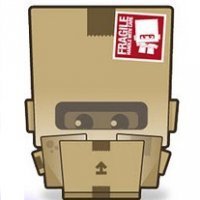
[MOC] Ferrari Monza SP1 & SP2
Cardboy posted a topic in LEGO Technic, Mindstorms, Model Team and Scale Modeling
This is my version of the Ferrari Monza SP1 & SP2 in 1:8 scale. There are two models in ‘one’. I designed this model to be played with as well as look good on a shelf like a proper Lego set should be You can get he instructions here Features and Functions: · opening doors, bonnet/hood and boot/trunk · independent suspension · Akerman steering geometry · 8 + N + R sequential gearbox without the need for a drive and reverse selector (inspired by Anto) · paddle shift gear selection · rear-wheel drive · detailing on the interior, virtual windscreen and engine Dimensions: Length: 73 Studs (59cm); Width: 35 Studs (28cm); Height: 17.5 Studs (14cm) Weight: 2.8 Kg -
Terra Station Z is a space station which be used for researching ores. Inside the Ore Research Centre, there are several research devices and robotic devices for splitting ores. Theres also an motorized conveyor belt for transporting the ores inside the station. Theres also a communication centre, for communication with spaceships and controlling/monitoring drones. This was a part of our Lowlug community Neo Classic Space layout. 01_Terra_Station_Z by Mathijs Bongers, on Flickr 02_Terra_Station_Z by Mathijs Bongers, on Flickr 08_Terra_Station_Z by Mathijs Bongers, on Flickr 11_Terra_Station_Z by Mathijs Bongers, on Flickr 13_Terra_Station_Z by Mathijs Bongers, on Flickr 14_Terra_Station_Z by Mathijs Bongers, on Flickr Pictures also on Flickr: https://www.flickr.com/photos/mathijslegofan/albums/72177720311251724/with/53191969795/
- 19 replies
-
- legomathijs
- moc
-
(and 3 more)
Tagged with:
-
Presenting another of my Danish State Railways’ (DSB) trains redesigned to 8-wide and digitally rendered (with a bonus livery)... DSB IC3 The Danish State Railways’ (DSB) highly successful and innovative InterCity 3 aka IC3 passenger train was co-developed by Siemens -Duewag in Germany and ABB Scandia in Denmark. The train is operated by DSB in Denmark and Sweden, by Renfe Operadora in Spain and by Israel Railways in Israel. Amtrak in the USA and Via Rail in Canada have tested the train in the past. A trainset consists of three units; two diesel motor units (Litra MFA and Litra MFB) and one intermediary unit (Litra FF). Up to five trainsets can be coupled together. 96 trainset were built for DSB from 1989 to 1991. All are still in service today. My model: Original white and red livery used from 1989 to 2002. Fictionally named “Jørgen Vig” with the crest of Billund added. Scale: 1:48 Length: 157 studs (MFA: 55 – FF: 47 – MFB 55) or approx. 122 cm Width: 8 studs Bricks: 2.948 (MFA: 1.040 – FF: 861 – MFB 1.047) Locomotion: 2 x 9v or 2 x PF/PUP train motors Power: 9v, 2 x LEGO AAA battery boxes or 2 x BuWizz battery boxes Control: 9v, PUP, SBrick, PFx Brick or BuWizz Designed: 2022 Conversion of my 7-wide model from 2017 to 8-wide with more accurate dimensions. Very high setting render from Stud.io with custom decals added in the PartDesigner tool. Its able to navigate R40 but looks rather silly doing so: Interior with seats for 83 minifigs: Decorative side design for the bogies - a combination of parts and the molded decorative side for train motors: The coupling part can be change to a Liftarm Thin 1x7 (BL#32065) when combining several trainsets. Technique used for the sliding doors: Removing the 1 x 4 Tile as shown enables the door to slide open as a play feature. The fixed outer doors are a necessary part of the construction otherwise the very long body breaks too easily due to the roof being removable. However, they are designed to be rebuilt open when needed and the trainset stationary on display: The trainset is (fictionally) named Jørgen Vig with the crest of Billund added: Free building instructions: Option 1: https://open-l-gauge.eu/dsb-ic3/ Option 2: https://snakebyte.dk/lego/instructions/trains/diesel_engines/dsb_ic3_(8_wide)/index.php Bonus livery: Livery when Amtrak tested the IC3 Flexliner DMU (Diesel Multiple Unit ) in 1997:
-
XL two track railway locomotive shed (finished in real bricks 10/4/23)
Murdoch17 posted a topic in LEGO Train Tech
This model was originally built by my father around 2005 / 2006 for an old 9v-style MOC steam engine we built together based off set 7722. It was three tracks long and one track wide at first, but I reworked it to be five tracks long and two tracks wide in late 2015. Both of these earlier models were almost totally black with a little splash of red. Fast forward to 2023: I have remodeled the MOC almost entirely. I've changed most of the black to tan, blocking up the lowest row of windows, and changing the red doors to light gray. The roof remains untouched except for twelve parts above the doors / back wall. The building is a little under 5 tracks long, or about 75 studs in length. The maximum side clearance is good enough for a 10 stud wide model (no overhang at that width) while the trains can be no more than 11 bricks tall. Here we see the rear of the MOC. The roof comes off and the inside has a new raised platform to allow for maintenance to the engines. (before it was just totally empty) This model can hold most of my steam engine designs (not all at once of course!), although it is probably too short in length for some of my diesel units. The dismantled 2015 version is in the spoiler tag. EDIT 10/4/23: Real pictures added, entire post restructured. Thoughts?- 12 replies
-
- large
- large model
-
(and 5 more)
Tagged with:
-
I'm happy to present my most recent build, a midwestern grain train from the late 1970's in the US. I've been working on it for most of this year, though the inspiration and some parts purchases date back to 2006. Towards the end of last winter I had been train watching and after about a half dozen trains, each led by a couple of black locomotives pulling a mile long monochromatic string of cars, it got me thinking about an underappreciated heyday. Between 1960 and 1990 American freight cars were a burst of color, and even had a few hints of the old school railroad pride shining through, e.g., Milwaukee Road spending the extra dollar to weld a plate on the side of their covered hoppers declaring themselves "America's Resourceful Railroad." The freight cars were 100% utilitarian in design, but in the bright colors they went a little further and said, "look at me," with each car taking a different hue. Since then, freight cars have drifted back to browns and grays only flashing a random graffiti tag for flare after a night of hanging around with the wrong crowds. I wanted to capture that era in the days just after KarTrak Automatic Car Identification's failure showed how dirty railroading in America can be. But how and what? I've always had a soft spot for covered hopper cars, in particular those based on the Pullman Standard 3 bay design. I had a go at these cars in 2006 Shortly thereafter, I started collecting 1x2 door rail plates and double convex inverted slopes in yellow to build a Milwaukee Road version. Those parts sat in a box and I hadn't returned to that prototype until now. On the flip side, I had most of the parts in hand that I needed to start testing this build. Happy with the prototype, I expanded to 5 different liveries. These covered hoppers are 6 wide, featuring custom decals. With their weight they need roller bearing trucks, to ensure the trucks match the width of the car they use custom truck sides from TrainedBricks.com. At this scale it is impossible to get all of the details, so in this design I focused on capturing the essence, e.g., a continuous slope for the bins from the end of the car to the bottom of the chute, using thin vertical and horizontal members on the ends of the cars. Several of the cars have prototypical placards 1/2 plate out from the ribbing. A couple of the cars consumed almost all of the double convex inverted slopes available on bricklink in the given color. As with most of my designs, these cars are designed to negotiate R40 curves, and in turn, replicating the form of the prototype gave me a true appreciation of the design of the actual cars. Of course, once you start down the rabbit hole of looking at covered hopper cars, you wind up seeing lots of other cool cars... and the potential to build in colors that do not have door rails (dark green). Well, next thing I knew, I also had a design for the ACF center flow covered hopper cars. Once more the covered hoppers are 6 wide. These cars were designed as a complement to the Pullman Standard cars to fill out the fleet and bring in a few more colors/liveries. Why stop at 8 cars? Good question, of course you need a Canadian cylindrical covered hopper, who doesn't need a cylindrical hopper car? So I built one too. Now I know you've all been there, you build a MOC and then discover you need a second MOC to support the first MOC (or in this case, a 10th MOC to support the first 9). When I started out I did not worry too much about what would pull these cars. I have a few period appropriate 9v locomotives, most recent of which are from 2014, a pair of SW1200's. While there was one major solution (FX Track) two problems remained, (1) my old 9v locomotives were not powerful enough to pull the full train, and (2) it has been over a decade since I've run 9v trains in public. I originally thought that I would eventually address #2 at some later point in time, but #1 escalated the need. So off I went to build a period appropriate PF locomotive. I returned to MNS, the same road as the SW1200's. Minneapolis Northfield and Southern was a spunky shortline with a long history and a large fan club for a railroad with just over 80 miles of track. They had a history of unusual locomotives starting with their predecessor, the never electrified Dan Patch Electric Lines and the first successful gas-electric locomotive that was the predecessor to diesel electric locomotives, to a fleet of massive Baldwin center cab locomotives built in the late 40's (nicknamed the "blue dragons"), and their last purchased locomotives the SD39's in 1968. These were essentially SD40's with smaller prime movers (and thus, lower horsepower). They were painted in a distinct dark blue with a single white stripe running the length of the locomotive. The SD39's served until the MNS was purchased by Soo Line in 1982 and one has returned to the shortline (Progressive Rail) that now operates a portion of the old MNS route. My 6 wide SD39 has a lot packed inside, including 2 PF train motors, 1 rechargeable PF battery pack, an IR receiver, a pole reverser, and four weight bricks. Fitting it all in required some compromises, like filling the cab with the IR receiver, and my desire to make the white stripe brick built as much as possible made fitting the battery a lot more complicated. One obvious tradeoff is that the long hood is 5 studs wide to hide the battery, I would have preferred to keep it 4 studs wide. But also a little ingenuity to plow through some of the challenges. If you look closely at the side views, just above the fuel tank you can seek a small patch of dark gray from the battery. I used an old school 4.5v motor plate with 4x8 cutout to drop the battery down below the white stripe and snotted studs to hold the tiles on that cover the side of the battery. The build uses custom stickers, 3-axle motor covers and fan housings from trainedbricks.com, and custom railings to keep them closer to proportional than the brick built alternatives. But I did have to use the classic train wagon ends as a nod to the fact that this is a Lego train after all. Okay... just one more problem, I didn't have a respectable MNS caboose. So now I needed an 11th MOC to support the 10th. The MNS purchased 3 new bay window cabooses in 1972 and like the SD39's, these served until the MNS was purchased by Soo Line in 1982 and one has returned to the shortline (Progressive Rail) that now operates a portion of the old MNS route. The caboose is 6 wide (8 at the bays), featuring custom decals, roller bearing trucks to match the hopper cars. The net result is my all new MNS grain train, with 5 Pullman Standard 3 bay covered hopper cars, 3 ACF 3 bay covered hopper cars, 1 Canadian cylindrical covered hopper car, an MNS SD39 and MNS bay window caboose. All in liveries that would have been seen in the late 1970's or early 1980's. The total length is about 11 ft. All of the cars are 6 wide. Click here for a mediocre video of the train in action I hope you enjoy the train. Questions, comments and constructive suggestions are always welcome The full album is here
-

[MOC] Lego Technic Military Truck (Building Instructions)
makushima posted a topic in LEGO Technic, Mindstorms, Model Team and Scale Modeling
MOC Lego Technic Military Truck Building Instructions: https://play.google.com/store/apps/details?id=max.technic.building.instructions Lego Technic MOC - Military Truck (Building Instructions) Lego Technic MOC - Military Truck (Building Instructions)- 2 replies
-
- building instructions
- instructions
-
(and 5 more)
Tagged with:
-
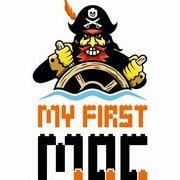
[ENTRY] 1873 & 6258 Pirate Treasure & Smuggler's Shanty - Remake 2023
MyFirstMOC-Hun posted a topic in Pirate MOCs
Hello! This time I combined two classic sets, Pirate Treasure 1873 and Smuggler's Shanty 6258. This is a small island where life goes on and there are traces of greed and a few skeletons to show for it. There are also several hiding places to stash your loot, gold bars and gold coins. Soldiers about to dock bring the pirates their pay for a job well done. On the island there is a fisherman who sells his wares, a tavern of course, a shelter for the captain, a defensive cannon to keep out intruders, at least until the pirates escape. But are there still drunks lying on the beach who can't understand how the rum ran out again? And let's not forget the old man pushing his wages on the little cart, waving to the barman that he'll soon be able to pour another batch of wine. Flickr Instagram -

[MOC] [LXF] Minifig-scale Phantom from Star Wars Rebels
ScottishDave posted a topic in LEGO Star Wars
This is a minifig-scale model of "The Phantom", the shuttle from the TV series "Star Wars Rebels". It's about a foot long and has a full interior, with working hatches at the rear and on the underside. I re-used the cockpit and nose from goatman461's excellent design, along with elements of the sides, roof and underside hatch: and I'm grateful for his kind permission to post this model. As usual, I've documented the build as an LXF file for my own reference, and I am linking the LXF file here in case anyone else feels like building this model. The LXF is nearly-but-not-quite correct. I can't place the roof (the angled pillars at the back prevent it from attaching) and the tyre with tread at the front of the engine should be an old smooth tyre (part no. 132) - something which does not appear to exist in LDD. Update: Many, many thanks to @monkypaws for making the instrctions available for free on rebrickable - link here. This page contains both a step-by-step set of instructions and a parts list. The details section contains a list of rare parts to check before attempting a build. Before someone asks: yes, I am pondering building the Ghost in scale with this shuttle. I estimate it would be quite large - 138 studs long, 1.1 metres, or the length of a stay in a local psychiatric hospital. Here are a couple of pictures. More can be found on the flickr album: Here are some photos of the Interior. First a shot from the front of the cockpit, showing Hera and Kanan, with the rest of the crew in the background (minus Chopper, who is in his droid socket on top of the ship). The belly hatch works, i.e. it opens and closes: There are eight seats in the back (realistically, seating for six, given the width of Lego figures): Once again, more photos can be found on the flickr album There is always room for improvement: If you have any suggestions, comments or criticisms, please feel free to leave them below. Edited 16th May: added interior photos.- 43 replies
-
- minifig scale
- phantom
-
(and 3 more)
Tagged with:
-
Hi! CP Comboios de Portugal recently gave a new color to the Nez Casse loco 2628, based on the former CP4700 from CP Carga (sold/turned to Medway) I have to be honest, I still have mixed feelings about this new livery, the orange is an iconic and complete eye-catcher, and still my favorite. However, making this one in LEGO started to grow on me. I will take some pictures alongside my Arco Coaches as soon as possible. the usual shout out to Raised and his NS1600/1800 and the Enhancements made by Erwin and Nicolas Tbx, my Nose/box design is based on their models. Circa 2000 parts 1Kg 43cm long 2 Powerfunctions L motors Buwizz 2.0 Custom working Lights Custom Vynil stickers designed by Tiago Vasconcelos
-
The Frisco 1522 loco is a 1926 oil burning 4-8-2 "Mountain" type, (4 leading, 8 drivers, 2 trailing) that was made surplus in 1951, donated to the Museum of Transportation (in St. Louis, Missouri) in 1959, and restored to working order in 1988 by the St. Louis Steam Train Association (SLSTA) for it's excursion career. It's new lease on life lasted until 2002 when rising insurance costs made the engine enter it's second retirement, which will be probably be forever. When the engine was running in it's second career, the SLSTA had four train cars in it's excursion support role. They carried parts, tools, merchandise to sell, and crew members not on duty. After re-retirement of the 1522, most of the cars were eventually sold to Milwaukee Road 261 organization and were renamed and repainted into a different paint scheme more suited to that group. This may not be the best interpretation of the Frisco 1522, but it seems to be the one of the few I've seen built out of Lego. The model you see here has been my dream ever since I was 5 or six years old and rode behind the steamer on one of it's last public trips. (I don't remember much of the trip, but I do remember the sense of awe and respect for the power of steam after seeing the loco pull past us on it's journey back to the museum and into what looks to be permanent retirement.) The cab walls on both model and real engine have the name of the railroad (Frisco) on it's side, while the number of the loco (1522) is on the tender sides. One half of this baggage car (named 'Black Gold' after a train the 1522 used to pull) housed tools, spare parts, lubricants and a fire hose or getting water for the loco, among many other things. The other half (usually closest to the engine) had the souvenir shop with shelves and tables for fundraising merchandise selling. The car is now repainted and named 'Golden Valley'. It has been used with Milwaukee Road 261. The 'Firefly' was the crew car. It was also named after a train the 1522 used to pull. The car has been sold to be used with Milwaukee Road 261. It sits in storage currently. The diner-lounge 'Chouteau Club' wasn't owned by the St. Louis Steam Train Association (SLSTA), but by a private individual who was a member of the club. It now is stored / owned by Illinois Transit Assembly in Madison, Illinois, sidelined by side sill rust. The 'Bluebonnet' was a business car and brought up the rear of the train. It was also named after a train the 1522 used to pull. The car has been sold to be used with Milwaukee Road 261. It has been renamed back to it's first name of 'Milwaukee' and repainted into the proper colors for that railroad. The real engine is publicly displayed at the Museum of Transportation in St. Louis, Missouri. The Lego model of the loco is sitting on the front of the loco, just above the cowcatcher. This official Frisco 1522 website gave me invaluable info and pictures of the excursion cars and the loco itself. This page in particular was very helpful in getting the window amount / spacing / 'look' of the excursion cars right. NOTE: Yes, I had a thread made in 2016 for the loco only. That thread was last updated in 2017, and I didn't want to mess with the moderators by bumping it. Thus, this new thread was created. I hope that was ok! EDIT: 9/23/23: Real world photos added!
-
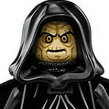
[MOC]-BW3001 - Pre-Orders Open! UCS Kintan Strider Speeder Bike
coreyschaaf posted a topic in LEGO Star Wars
UCS Kintan Strider Speeder Bike As featured in the Book of Boba Fett • by Corey Schaaf | BrickWars.net It's been fun putting this build together. I've worked with so many different people on executing this project. From working with a manufacturer for a custom case, to my signature Printed UCS Plaques, the unique serialized tiles that's different for every build, to the UCS Stickers from a company in the UK - to the final print production of my Limited Edition UCS Instruction manual — I can just about call this one complete. Pieces: 2,285 + 2 Minifigs Weight: 71.5 oz | 4.7lbs Width: 57.6 cm | 22.7 in Length: 25.6 cm | 10.1 in Height: 24.8 cm | 9.7 in Estimated Part Costs: $375-$450 My manual is built in the same way my original UCS instruction manual for the Resistance Troop Transport ship was designed but in a much smaller print run. Only 150 copies of my manual will be available. Email subscribers will be notified when the pre-sale starts, so if you're interested, I would encourage you to visit https://BrickWars.net/moc-bw3001 and signup via the email link at the bottom of the page. You can find all the details and specifications on my website for this build at https://brickwars.net/moc-bw3001. If you have any questions, feel free to ask! You can also give me a follow me on https://www.instagram.com/brickwarsnet/ as well. New Video of MOC Just added- 11 replies
-
- instructions
- custom instructions
- (and 12 more)
-
Hey guys! Here's a big update of my Imperial Base on Er'Kit. This build is both an extension of my long-planned project and an online collab with my friend Noah (H2Brick). Who motivated me to do this? Well, Noah did, whose part of the collab comes very soon. It's much more vertical than mine, I'm gonna spoil you just this. :D It was so nice to do multiple whatsapp/discord building calls with Noah and give feedback to each other. Hope you like this updated version of the base. I personally see some oversimplified areas that I can improve in the future. Don't worry, I'll work on them. I'm having an exam session now and I was grinding for the past 5 days to get this done. I guess it was worth it! :D BTW. The size of the moc is 2x3 gray 48x48 baseplates now, and will be expanded (again) this year! TIE Fighter by Jerac. AT-ST by Pablo Brickasso. 74-Z Speeder heavily inspired by Luca s projects. Ok, here are some pics: Huge thanks to CTR Bricks for editing the main pic! More detail shots in a Flickr album: And here is the september 2020 edition of the collab: Imperius Unitada Ober Totallex!
- 9 replies
-
- jan the creator
- stormtrooper
-
(and 5 more)
Tagged with:
-
This is my contribution to Lego Ideas, if you like it you can vote for it in the link below. https://ideas.lego.com/projects/fe056819-d65a-4e83-b75c-38398be6ac67



